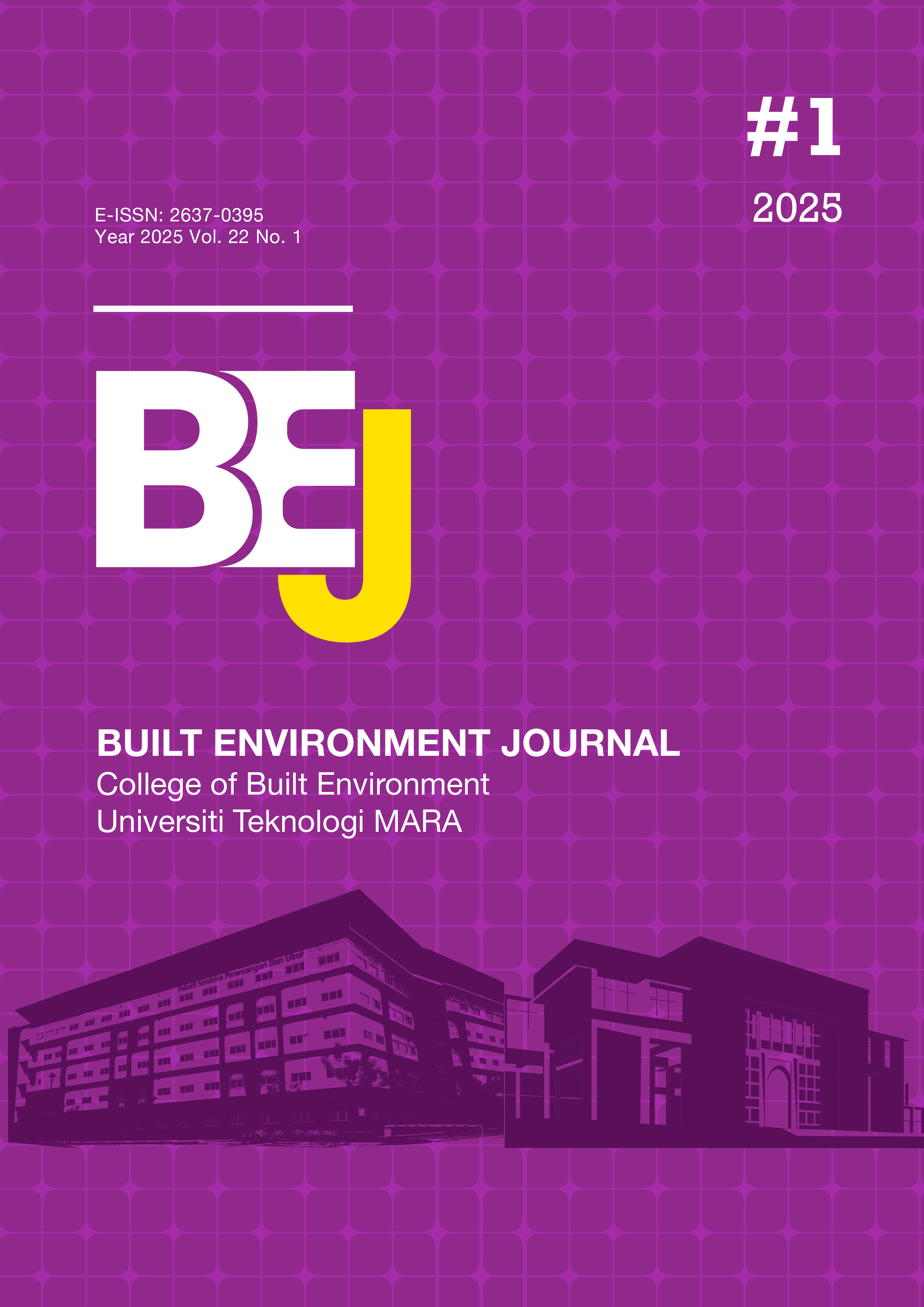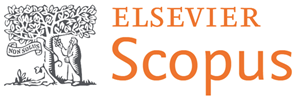Top Priority Characteristics of Blue Spaces Design for Stress Reduction: A Scoping Review and Delphi Technique Among BlueHealth Experts
DOI:
https://doi.org/10.24191/bej.v22i1.901Keywords:
Blue space, Stress, Healing-space, Delphi technique, Bluehealth experts, Scoping reviewAbstract
There is a growing need to identify blue space characteristics that optimize stress reduction. Few studies have directly linked specific variables of blue spaces to stress-reduction. To address this gap, this study aimed to develop a framework identifying priority blue space variables for stress reduction. A scoping review first compiled a comprehensive list of potentially influential factors. Using the Delphi technique, a qualitative study then evaluated the most significant of these variables through private interviews with eleven (11) BlueHealth experts. The experts, drawn from diverse disciplines, were asked to rate the importance of various blue space characteristics on a 6-point scale. The analysis revealed that factors such as size, colour/clarity, biodiversity, and time spent in the blue space may be the most critical for stress reduction. Experts highlighted the complex interrelationships between these variables, noting that the optimal design of blue spaces requires a delicate balance to maximize the stress-reducing potential. While further experimental validation is warranted, this expert-informed framework provides a solid foundation for designing blue spaces that support mental health and well-being. By prioritising the key variables and understanding their relative importance, architects, urban planners, and policymakers can make more informed decisions when creating or retrofitting blue spaces. The findings of this study come at a critical time, as the global mental health crisis continues to escalate, with depression and stress projected to be leading concerns by 2030. Integrating this evidence-based framework into the design of blue spaces holds the potential to mitigate the negative impacts of the built environment and contribute to the overall well-being of individuals and communities.
References
Ashbullby, K. J., Pahl, S., Webley, P., & White, M. P. (2013). The beach as a setting for families’ health promotion: A qualitative study with parents and children living in coastal regions in Southwest England. Health & Place, 23, 138–147. https://doi.org/10.1016/J.HEALTHPLACE.2013.06.005
Bakolis, I., Hammoud, R., Smythe, M., Gibbons, J., Davidson, N., Tognin, S., & Mechelli, A. (2018). Urban Mind: Using Smartphone Technologies to Investigate the Impact of Nature on Mental Well-Being in Real Time. BioScience, 68(2), 134–145. https://doi.org/10.1093/BIOSCI/BIX149
Beiderbeck, D., Frevel, N., von der Gracht, H. A., Schmidt, S. L., & Schweitzer, V. M. (2021). Preparing, conducting, and analyzing Delphi surveys: Cross-disciplinary practices, new directions, and advancements. MethodsX, 8, 101401. https://doi.org/10.1016/j.mex.2021.101401
Berman, M. G., Jonides, J., & Kaplan, S. (2008). The cognitive benefits of interacting with nature. Psychological Science, 19(12), 1207–1212. https://doi.org/10.1111/J.1467-9280.2008.02225.X
Berto, R. (2005). Exposure to restorative environments helps restore attentional capacity. Journal of Environmental Psychology, 25(3), 249–259. https://doi.org/10.1016/j.jenvp.2005.07.001
Beyer, K. M. M., Szabo, A., Hoormann, K., & Stolley, M. (2018). Time spent outdoors, activity levels, and chronic disease among American adults. Journal of Behavioral Medicine, 41(4), 494–503. https://doi.org/10.1007/S10865-018-9911-1/METRICS
Coughlin, R. E. (1976). The Perception and Valuation of Water Quality. Perceiving Environmental Quality, 205–227. https://doi.org/10.1007/978-1-4684-2865-0_11
Dallimer, M., Irvine, K. N., Skinner, A. M. J., Davies, Z. G., Rouquette, J. R., Maltby, L. L., Warren, P. H., Armsworth, P. R., & Gaston, K. J. (2012). Biodiversity and the Feel-Good Factor: Understanding Associations between Self-Reported Human Well-being and Species Richness. BioScience, 62(1), 47–55. https://doi.org/10.1525/BIO.2012.62.1.9
Dempsey, S., Devine, M. T., Gillespie, T., Lyons, S., & Nolan, A. (2018). Coastal blue space and depression in older adults. Health & Place, 54, 110–117. https://doi.org/10.1016/J.HEALTHPLACE.2018.09.002
Dijkstra, K., Pieterse, M., & Pruyn, A. (2006). Physical environmental stimuli that turn healthcare facilities into healing environments through psychologically mediated effects: systematic review. Journal of Advanced Nursing, 56(2), 166–181. https://doi.org/10.1111/J.1365-2648.2006.03990.X
Dinius, S. H. (1981). PUBLIC PERCEPTIONS IN WATER QUALITY EVALUATION1. JAWRA Journal of the American Water Resources Association, 17(1), 116–121. https://doi.org/10.1111/J.1752-1688.1981.TB02594.X
Fisher, J. C., Irvine, K. N., Bicknell, J. E., Hayes, W. M., Fernandes, D., Mistry, J., & Davies, Z. G. (2021). Perceived biodiversity, sound, naturalness and safety enhance the restorative quality and wellbeing benefits of green and blue space in a neotropical city. Science of the Total Environment, 755, 143095. https://doi.org/10.1016/j.scitotenv.2020.143095
Foley, R., & Kistemann, T. (2015). Blue space geographies: Enabling health in place. Health and Place, 35, 157–165. https://doi.org/10.1016/j.healthplace.2015.07.003
Garrett, J. K., Clitherow, T. J., White, M. P., Wheeler, B. W., & Fleming, L. E. (2019). Coastal proximity and mental health among urban adults in England: The moderating effect of household income. Health and Place, 59(August), 102200. https://doi.org/10.1016/j.healthplace.2019.102200
Gascon, M., Mas, M. T., Martínez, D., Dadvand, P., Forns, J., Plasència, A., & Nieuwenhuijsen, M. J. (2015). Mental health benefits of long-term exposure to residential green and blue spaces: A systematic review. International Journal of Environmental Research and Public Health, 12(4), 4354–4379. https://doi.org/10.3390/ijerph120404354
Green and New Evidence and Perspectives for Action Blue Spaces and Mental Health. (2021).
Herzog, T. R. (1985). A cognitive analysis of preference for waterscapes. J Environ Psychol, 5(3), 225–241. https://doi.org/10.1016/s0272-4944(85)80024-4
Karmanov, D., & Hamel, R. (2008). Assessing the restorative potential of contemporary urban environment(s): beyond the nature versus urban dichotomy. Landsc Urban Plan, 86(2), 115–125. https://doi.org/10.1016/j.landurbplan.2008.01.004
Moscoso, P., Peck, M., & Eldridge, A. (2018). Emotional associations with soundscape reflect human-environment relationships. Journal of Ecoacoustics, 2(1), 1–1. https://doi.org/10.22261/JEA.YLFJ6Q
Nasar, J., & Lin, Y. H. (2010). Evaluative Responses to Five Kinds of Water Features. Http://Dx.Doi.Org/10.1080/0142639032000150167, 28(4), 441–450. https://doi.org/10.1080/0142639032000150167
Nutsford, D., Pearson, A. L., Kingham, S., & Reitsma, F. (2016). Residential exposure to visible blue space (but not green space) associated with lower psychological distress in a capital city. Health & Place, 39, 70–78. https://doi.org/10.1016/J.HEALTHPLACE.2016.03.002
Page, M. J., McKenzie, J. E., Bossuyt, P. M., Boutron, I., Hoffmann, T. C., Mulrow, C. D., Shamseer, L., Tetzlaff, J. M., Akl, E. A., Brennan, S. E., Chou, R., Glanville, J., Grimshaw, J. M., Hróbjartsson, A., Lalu, M. M., Li, T., Loder, E. W., Mayo-Wilson, E., McDonald, S., … Moher, D. (2021). The PRISMA 2020 statement: An updated guideline for reporting systematic reviews. The BMJ, 372, 2020–2021. https://doi.org/10.1136/bmj.n71
Pitt, H. (2018). Muddying the waters: What urban waterways reveal about bluespaces and wellbeing. Geoforum, 92, 161–170. https://doi.org/10.1016/J.GEOFORUM.2018.04.014
Pretty, J., Peacock, J., Sellens, M., & Griffin, M. (2005). The mental and physical health outcomes of green exercise. International Journal of Environmental Health Research, 15(5), 319–337. https://doi.org/10.1080/09603120500155963
Ratcliffe, E., Gatersleben, B., & Sowden, P. T. (2020). Predicting the Perceived Restorative Potential of Bird Sounds Through Acoustics and Aesthetics. Environment and Behavior, 52(4), 371–400. https://doi.org/10.1177/0013916518806952
Smith, D. G., Croker, G. F., & McFarlane, K. (1995). Human perception of water appearance—2. Colour judgment, and the influence of perceptual set on perceived water suitability for use. N Z J Mar Freshw Res, 29(1), 45–50. https://doi.org/10.1080/00288330.1995.9516638
Toet, A., Henselmans, M., Lucassen, M. P., & Gevers, T. (2011). Emotional effects of dynamic textures. I-Perception, 2(9), 969–991. https://doi.org/10.1068/i0477
Ulrich, R. S., Simons, R. F., Losito, B. D., Fiorito, E., Miles, M. A., & Zelson, M. (1991). Stress recovery during exposure to natural and urban environments. Journal of Environmental Psychology, 11(3), 201–230. https://doi.org/10.1016/S0272-4944(05)80184-7
Villa, H., Zaino, A. A., Rasiya, A., Banaei, M., Abdullah, J., Abbas, M. Y., & Azman, H. (2022). Not all Blue-Spaces are Created Equal: Variables affecting restorative outcome of indoor blue-spaces-A scoping review. Environment-Behaviour Proceedings Journal, 7(20), 121–127. https://doi.org/10.21834/EBPJ.V7I20.2262
Völker, S., & Kistemann, T. (2011). The impact of blue space on human health and well-being - Salutogenetic health effects of inland surface waters: A review. International Journal of Hygiene and Environmental Health, 214(6), 449–460. https://doi.org/10.1016/j.ijheh.2011.05.001
Völker, S., & Kistemann, T. (2013). “I’m always entirely happy when I’m here!” Urban blue enhancing human health and well-being in Cologne and Düsseldorf, Germany. Soc Sci Med, 78(1), 113–124. https://doi.org/10.1016/j.socscimed.2012.09.047
Völker, S., & Kistemann, T. (2015). Developing the urban blue: Comparative health responses to blue and green urban open spaces in Germany. Health & Place, 35, 196–205. https://doi.org/10.1016/J.HEALTHPLACE.2014.10.015
Völker, S., Matros, J., & Claßen, T. (2016). Determining urban open spaces for health-related appropriations: a qualitative analysis on the significance of blue space. Environmental Earth Sciences, 75(13). https://doi.org/10.1007/s12665-016-5839-3
White, M., Smith, A., Humphryes, K., Pahl, S., Snelling, D., & Depledge, M. (2010). Blue space: The importance of water for preference, affect, and restorativeness ratings of natural and built scenes. Journal of Environmental Psychology, 30(4), 482–493. https://doi.org/10.1016/j.jenvp.2010.04.004
Zaino, A. A., & Abbas, M. Y. (2020a). Architectural Space Alters the Expression of Gene that Regulate Physical and Emotional Stress. Asian Journal of Environment-Behaviour Studies, 5(16), 1–19. https://doi.org/10.21834/ajebs.v5i16.366
Zaino, A. A., & Abbas, M. Y. (2020b). Blue-Space Restoration Theory extends the Understanding of the Quranic Verses of Water. Environment-Behaviour Proceedings Journal, 5(14), 211–218. https://doi.org/10.21834/ebpj.v5i14.2195
Zaino, A. A., & Abbas, M. Y. (2020c). Single-case Experimental Research: Designing emotions by designing spaces - A pilot study. Environment-Behaviour Proceedings Journal, 5(13), 183. https://doi.org/10.21834/e-bpj.v5i13.2103
Zaino, A. A., & Rasiya, A. (2022). A cE-Bs2022Cherating Not all Blue-Spaces are Created Equal : Variables affecting restorative outcome of indoor blue-spaces-A scoping review. Environment-Behaviour Proceedings Journal, 7(20), 121–127. https://doi.org/10.21834/ebpj.v7i20.2262
Downloads
Published
How to Cite
Issue
Section
License
Copyright (c) 2024 Ammar Ayman Zaino, Jamalunlaili Abdullah, Aishath Rasiya

This work is licensed under a Creative Commons Attribution-NonCommercial-NoDerivatives 4.0 International License.
CC BY-NC-ND 4.0 DEED
Attribution-NonCommercial-NoDerivs 4.0 International












